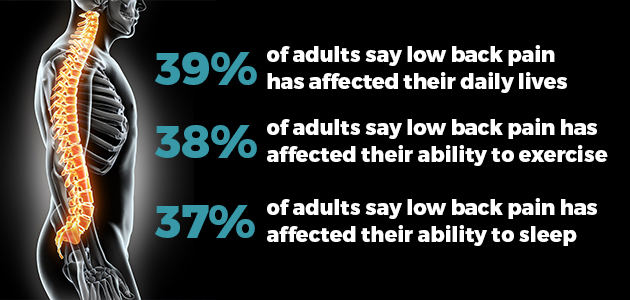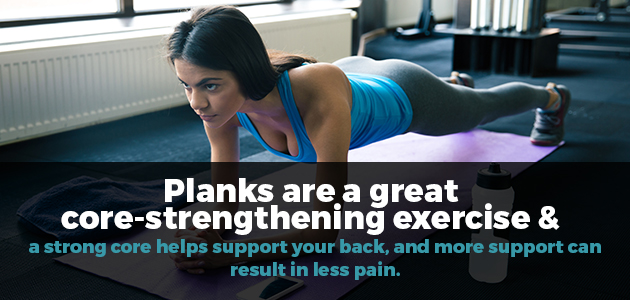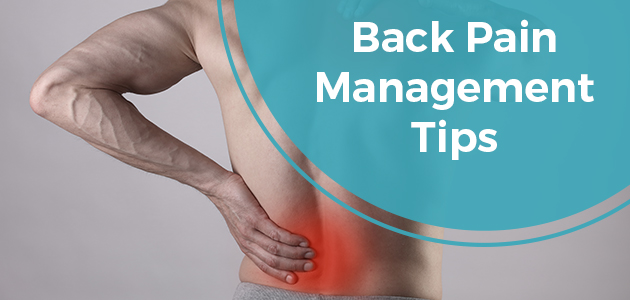What is Facet Nerve Ablation? Those who are seeking degenerative disc disease treatments have probably come across facet nerve ablation in their searches. But, is this an effective method of treating your degenerative disc disease…
Anyone who has ever experienced back pain knows how debilitating it can be. In a survey on low back pain the American Physical Therapy Association found:
- 39 percent of adults say low back pain has affected their daily lives
- 38 percent of adults say low back pain has affected their ability to exercise
- 37 percent of adults say low back pain has affected their ability to sleep
The majority of low back pain cases, approximately 90 percent, resolve within six weeks, seven percent of cases do become a chronic issue, according to The Good Body. Before you start worrying about starting regular medication, remember that there are simple back pain management options you can try at home. Learn more about what causes back pain and what you can do to manage your symptoms with our guide to pain management for back pain.

Common Causes of Back Pain
Although back pain is a common issue, just one out of 10 people actually know the root cause of their discomfort, according to The Good Body. It is a good idea to know the biggest culprits behind back pain before you decide to treat yourself at home.
- Arthritis.Arthritis is a type of disease that affects the joints. The varying types of arthritis, include osteoarthritis, inflammatory arthritis, infectious arthritis, and metabolic arthritis. Any type of arthritis can affect the back and cause pain. A primary care physician can recommend an exercise particular to your type of arthritis.
- Disc injury. Discs, the cartilage that separates each of your vertebrae, can suffer injury or degeneration. Discs can bulge or rupture entirely. This can, but not always, cause pain. Imaging tests are the quickest way to eliminate this possibility.
- Skeletal issues. An anatomical issue, such as scoliosis, can be the cause of back pain. Your primary care physician can help you determine if this avenue of investigation is worth exploring.
- Strain. Strain can affect the muscles and ligaments in your back, leading to pain. Heavy lifting, sitting at a desk all day or even sleeping in the wrong position can result in strain.
Think about what you do each day, and try to see if there is a causal relationship between any activity and your back pain. It is also helpful to know your family’s health history and your risk factors.

At-Home Remedies for Back Pain
If you have determined your back pain is caused by simple strain, rather than a more serious underlying issue, you have the power to manage your symptoms with some simple at-home back pain management treatments.
Ice, heat and medication are some of the most common ways to ease back pain. The American Physical Therapy Association survey found that 72 percent of people who have experienced low back pain turn to medication as a means of relief, while 55 percent of people use a combination of heat compresses and ice to manage their symptoms.
In addition to medication and topical treatments, like heat and ice, you can consider lifestyle changes that may have a significant impact on your back pain. Your weight can play a big part in back pain. Obesity places undue strain on the muscles and ligaments in your back. Consider finding ways to help maintain a healthy weight. Other issues that could be contributing to your back pain include:
- How you lift heavy items. Always remember to take it easy on your back when you lift something heavy. Bend at the knees, allowing your legs to put in most of the work instead of your back.
- The shoes you wear. High heels, while fashionable, can be a big back pain contributor. Likewise, shoes with not enough cushion for your feet can cause issues. Try to find shoes with the right level of comfort and support.
- Your mattress. Sleep is a big part of your overall health. The wrong mattress can be the reason behind your back pain. Aim for a mattress with enough firmness to prevent your spine from curving too much.
- Smoking. Smoking has a negative effect on your overall health, and it can even be the reason your back hurts. Consider cutting back or quitting altogether.
One of the biggest issues is a lack of exercise. Consider adding regular exercise to your schedule to help keep your body in shape and minimize back pain. In addition to a healthy level of activity, you can add exercises specifically designed to address back pain.

Exercises for Management of Low Back Pain
If you are plagued with an aching low back, you can try a few simple stretches and exercises to alleviate your symptoms. Even if your symptoms disappear, these exercises can become a healthy routine to help avoid future issues.
- Planks. Planks are a great core-strengthening exercise. A strong core helps support your back, and more support can result in less pain. To do a plank, get into the push-up position. Instead of placing your hands flat on the floor, rest your forearms on the floor. Keep your back straight and engage your core muscles. You can also do planks on each side of your body. Roll to the side and support your weight with that forearm while still keeping your body straight.
- Knee-to-chest stretches. Lie on the ground flat on your back, bend your knees, and leave your feet flat on the ground. First, pull one leg to your chest with both hands and hold it there for a few seconds. Switch to the next leg. Then, you will use your hands to pull both legs to your chest. This exercise can be done two or three times a day.
- Child’s pose. This stretch will be familiar to anyone who has ever done yoga. Put your hands and knees on the floor. Bring your toes together and then lean your hips back until you are resting your glutes on your legs. Reach your arms out in front of you. You can place your palms and your forehead flat on the floor. This is considered a restorative posture in yoga. You can stay in this stretch for a minute or so or longer if it continues to feel good.
- Hip lifts. Lie flat on the floor with your knees bent and your feet on the ground. Use the muscles in your abs and glutes to lift your hips toward the ceiling while keeping your feet on the ground. Once your hips are lifted, hold the position for a few seconds. Try to do several repetitions of this stretch.
- Low back rotation. Low back rotations are a nice way to stretch the muscles in both your lower back and your glutes. Lie flat on your back on the ground, and stretch your arms out to the side in a “T” position. Then bend your knees and place them to one side of your body. Be sure to keep your shoulders connected to the ground. Switch sides. You can stretch each side for 30 seconds or so.
- Cat and cow stretches. Another one from the yoga playbook, cat and cow stretches are a gentle way to stretch out the muscles in your lower back. Begin with your hands and knees on the floor. Keep your spine straight. You will look similar to a table. To do cat stretch, imagine exactly how a cat looks while arching its back. Do the same movement with your own back. Hold the gentle arch in your back for a few seconds, and then drop your belly toward the ground to arch your back in the opposite direction. Switch back and forth between cat and cow for a minute or more.
Exercises for Mid-Back Pain
Low back pain might be extremely common, but that isn’t the only place pain can strike. You might suffer from discomfort in the middle of your back. Here are a few exercises you can try out to alleviate those symptoms.
- Chest stretch. Your chest muscles are often a seat of tension, which can in turn cause discomfort in your back muscles. Stretching your chest is a simple way to help alleviate some of this tension. Stand with your feet at least hip distance apart. Clasp your hands behind your back, and lean forward while allowing your arms to extend upward. You can hold the position for about half a minute.
- Toe touch. Sit down on the floor with your legs straight out in front of you. Slowly arch your back as you reach for your toes. Don’t worry if you can’t quite reach. Instead place your hands on your thighs or shins, as far as you can go. This position is about stretching your back muscles, not pushing yourself beyond your flexibility limits. Do this stretch a few times a day.
- Pull-up bar stretch. This stretch does require some help from a piece of equipment. Use a pull-up bar at the gym, or install one at home. First, hold onto the bar with your hands facing forward. Simply hang in a static position, allowing gravity to help stretch the muscles in your mid back. Next, rotate your hands and hang with an underhand grip. Allow at least a few seconds to feel the stretch.
- Back bend. This exercise might sound like something for a gymnast, but it is actually a simple, passive stretch. Place a rolled up towel or yoga mat beneath your back. Line up the top of the roll up with the bottom of your shoulder blades. Lie with your arms in a “T” position. This prone position will help ease some tension in your middle back. If you are looking for a deeper stretch, you can swap out the rolled up towel for a yoga mat.
- Cobra stretch. Cobra pose, another yoga staple, is named for its snake-like posture. Lie on your stomach with your legs straight behind you. Bend your arms and place your hands on either side of your body below your shoulders. Use your back muscles to help pull your chest up off of the ground. Remember to use your back muscles, instead of pushing with your hands and arms. You can even lift your hands a few inches off of the ground to see how much work your back is doing. This exercise helps stretch out tense muscles and helps you strengthen those same muscles.
- Seated twist. Sit on the ground with your legs crossed. Concentrate on keeping your back very straight. Twist by moving your chest to one side. Keep your legs firmly connected to the ground. You can look over your shoulder in the direction you are twisting. Hold the position for a few seconds, and switch sides.
- Head tilt. This exercise is a great way to help ease sore muscles into an exercise routine. Sit in a chair with a straight back and both feet firmly planted on the ground. Lean your head to one side as far as possible. Repeat this stretch several times before switching to the other side. Remember to keep your arms and shoulders relaxed, instead engage the muscles in your neck and upper back.

Exercises for Upper Back Pain
Pain in your upper back is likely related to the muscles in your neck, shoulders, and chest. Here are a few simple stretches and exercises to address those areas of your body.
- Wall stretch. You can do this exercise at home. You can even try it out in the office if you have a spare moment. Stand a few feet away from a wall facing forward. Reach out your hands until your palms are flat on the wall. Bring your hands down until they are at the same level as your waist. Keep your back and neck straight. You will feel the muscles in your upper back stretching.
- Shoulder rolls. You can do this simple exercise anywhere. Stand up straight and roll your shoulders forward, making large circles. Eventually, roll those muscles forward in small circles. Next, roll your shoulders backward using the same process.
- Strap stretch. You can do strap stretch with a yoga strap, a belt, or an exercise band. Sit down in a straight-back chair. Hold the strap in your hands, and raise your straight arms above your head. Let your chin rest on your chest, stretching the muscles in your neck and upper back. You can hold this stretch for as long as you want and repeat it as often as you like.
- Doorway stretch. This stretch is easy to do at home. All you will need is an open doorway. Stand in the doorway, and place your arms against the side of the doorframe at a 90-degree angle. Leave your arms there as you begin to move forward. You will feel a stretch across your chest and through your shoulders. These muscles are often the source of upper back pain. Hold this stretch for about 30 seconds. You can try doorway stretch multiple times in a day.
The key to any of these exercises is consistency. Try to build the exercises that seem the most effective for you into your daily routine. The more consistently you stick to these exercises the more beneficial they will be over the long term. If you are still experiencing pain, be sure to reach out to your physician for guidance.

